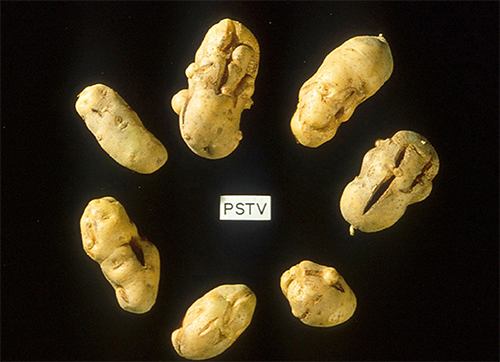6.4 – Viroids, Virusoids, and Prions
Learning Objectives
- Describe viroids and their unique characteristics
- Describe virusoids and their unique characteristics
- Describe prions and their unique characteristics
Research attempts to discover the causative agents of previously uninvestigated diseases have led to the discovery of nonliving disease agents quite different from viruses. These include particles consisting only of RNA or only of protein that, nonetheless, are able to self-propagate at the expense of a host—a key similarity to viruses that allows them to cause disease conditions. To date, these discoveries include viroids, virusoids, and the proteinaceous prions.
Viroids
In 1971, Theodor Diener, a pathologist working at the Agriculture Research Service, discovered an acellular particle that he named a viroid, meaning “virus-like.” Viroids consist only of a short strand of circular RNA capable of self-replication. The first viroid discovered was found to cause potato tuber spindle disease, which causes slower sprouting and various deformities in potato plants (see Figure 6.24). Like viruses, potato spindle tuber viroids (PSTVs) take control of the host machinery to replicate their RNA genome. Unlike viruses, viroids do not have a protein coat to protect their genetic information.

Viroids can result in devastating losses of commercially important agricultural food crops grown in fields and orchards. Since the discovery of PSTV, other viroids have been discovered that cause diseases in plants. Tomato planta macho viroid (TPMVd) infects tomato plants, which causes loss of chlorophyll, disfigured and brittle leaves, and very small tomatoes, resulting in loss of productivity in this field crop. Avocado sunblotch viroid (ASBVd) results in lower yields and poorer-quality fruit. ASBVd is the smallest viroid discovered thus far that infects plants. Peach latent mosaic viroid (PLMVd) can cause necrosis of flower buds and branches, and wounding of ripened fruit, which leads to fungal and bacterial growth in the fruit. PLMVd can also cause similar pathological changes in plums, nectarines, apricots, and cherries, resulting in decreased productivity in these orchards, as well. Viroids, in general, can be dispersed mechanically during crop maintenance or harvesting, vegetative reproduction, and possibly via seeds and insects, resulting in a severe drop in food availability and devastating economic consequences.
Check Your Understanding
- What is the genome of a viroid made of?

